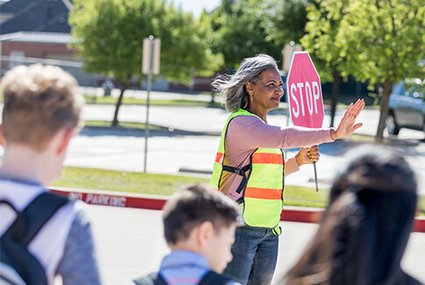School zones: traffic rules and precautions

During rush hour, school zones are teeming with vehicles, children, and people accompanying them. Observing traffic rules and being on the lookout are fundamental to the safety of everyone. Do you know proper school zone etiquette?
Follow traffic signs
Here’s a quick refresher on school zone traffic signs.
Slow down when approaching a school zone
When entering a school zone, remember to check the posted speed limit. While the Highway Safety Code sets the speed limit at 50 km/h, the speed limit in school zones is almost always 30 km/h, and fines for speeding in these zones are doubled during school hours. Why? School zones are high-risk areas with small and hard-to-see children, busy streets and pedestrian crossings, and unpredictable pedestrian behaviour. Always be on your guard In school zones!
Respecting the authority of school safety patrols
School safety patrollers of all ages are part of the CAA-Quebec School Safety Patrol. They help children cross the street safely. Under section 311 of the Highway Safety Code, any person, whether motorist, cyclist or pedestrian, must obey their orders. Make it easy for patrollers—always stop your vehicle when you see a child crossing. Children are easily distracted and sometimes walk slowly. So be patient and smile as they cross the street!

School buses have priority
In Quebec, you must stop your vehicle more than 5 metres away from a school bus when its intermittent red lights are flashing or its mandatory stop sign is activated, whether you are behind it or going in the opposite direction (s. 460 of the Highway Safety Code). Once the red lights are off and the stop sign is deactivated, you may resume driving. Be mindful of children who might appear unexpectedly. Note however that you’re not required to stop when passing a school bus if it’s travelling the other way on a divided roadway and is not at an intersection where schoolchildren can cross.
Proper use of drop-off areas
It’s important to be familiar with the location of your school’s drop-off areas and where they are located in relation to designated entrances and exits. If the drop-off area is occupied, wait for a space to become available instead of double parking or parking in an unauthorized spot to drop off your child.
Using the right car seat
In Quebec, the law requires that children be seated in a car seat adapted to their weight and height until they are 145 cm tall or 9 years old and can use a seat belt alone. Depending on the child’s weight and height, a booster seat may be required. Société de l’assurance automobile du Québec provides detailed information on children’s car seats.
Walking with your kids
Have you ever considered parking at a distance and then walking your kids to school? This is a good time to instill positive behaviour in your children and explain road signs and basic safety rules. Even if your children go to school by themselves, take time to walk the route with them at the beginning so you can identify high-risk areas and stress the need to be careful.
Avoid parking lots
Because of reduced visibility and limited space, parking lots pose a risk to drivers and pedestrians. Even if spaces are available in the visitor section, be careful and park a little farther away to reduce traffic around the school.
Test your knowledge with these true or false statements
1. Riding a school bus is 10 times safer than driving to school.
TRUE. Riding a school bus is 10 times safer than driving to school.
2. Motorists who fail to stop when passing a school bus with activated flashing red lights will get a warning at the first offence.
FALSE. Drivers face a fine of $200 to $300 (cyclists face a fine of $80 to $100) and nine demerit points on their record.
3. No action is required of motorists when a bus’s four amber warning lights are flashing.
FALSE. School-bus drivers must signal their intention to stop, either by activating the vehicle’s four flashing amber warning lights or the hazard lights. This mandatory pre-signal is designed to ensure that oncoming motorists do not brake abruptly. Motorists approaching a school bus should slow down as soon as they see the amber lights.
4. It’s strictly forbidden to pass a school bus at any time.
FALSE. In a zone where passing is allowed, motorists may overtake a school bus when its red lights are off and its stop sign deactivated.

Benefit from personalized advice
Do you have questions about gas-powered or electric vehicles, driving, or need recommendations to find an Approved Auto Repair Service?



